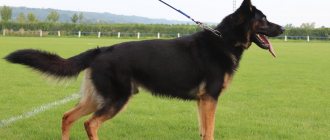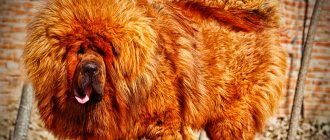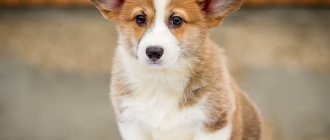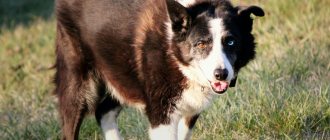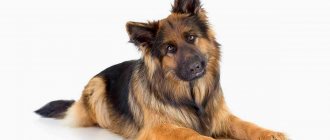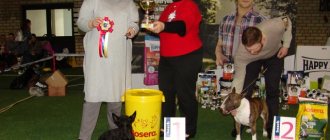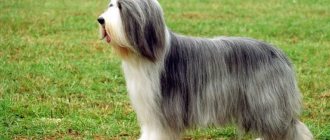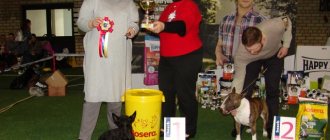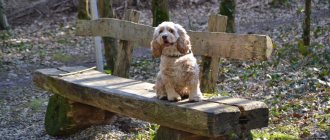- German Shepherd
The German Shepherd is one of the most popular dog breeds in the world. This is an intelligent and capable service dog. His dedication and courage are unmatched. He is amazingly versatile and trainable, one might even say universal. The German Shepherd is people-oriented, because of this, with proper upbringing and training, he is taken as a guide dog, as a rescue dog, for protecting territory or livestock, as a bodyguard, search and rescue, drug detection, and as a faithful companion and companion, he is irreplaceable.
- Country of origin : Germany
- Height at withers : male: 60-65 cm, female: from 55-60 cm
- Weight : male: 30-40 kg, female: 22-32 kg
- Lifespan : 9-13 years
- Usage : Service dog, watchdog, shepherd, companion dog
Purchasing a German Shepherd puppy is a responsible and important action that you need to think carefully about before you do it. This is especially true for those people who are going to become truly responsible dog breeders. The question of choice should be approached carefully and without haste, comparing your own habits, daily routine and the nature of the chosen breed. When the future owner has decided on the breed, a new dilemma arises: how to find a bona fide breeder? Here you need to be extremely careful not to become a prematurely disappointed dog owner.
Buying a German Shepherd puppy is a very exciting event, because you can say that a new family member will appear. To ensure that the event does not overshadow anything, it is worth taking a responsible approach to choosing a breeder. There are no bad dog breeds; you can simply run into an unscrupulous breeder for whom money comes first. The future owner is at great risk of buying an animal that has a lot of health problems. It is for this reason that you need, first of all, to get to know the breeder well, read reviews about him and the like.
Care and maintenance of an adult black German shepherd
The Black German Shepherd is an unpretentious and undemanding animal. Like its relatives, it will adapt to any living conditions; only the owner must take into account the peculiarities of living on the street or in an apartment.
The right diet
There are two diet options for Germans: natural, industrial.
The most convenient, but not the cheapest option is ready-made dry food. Preference is given to premium and super-premium class. Economy class feed is of poor quality and poorly balanced. They can lead to diseases of the gastrointestinal tract.
A natural diet should consist of two-thirds lean meat (chicken, veal, turkey) and offal. Rest:
- Vegetables and fruits.
- Porridge.
- Greenery.
- Low-fat fermented milk products.
- Boiled sea fish without bones.
Walking and physical activity
Even if the dog lives on the property, he needs street walks. This is especially true for dogs living in an apartment. The dog should spend 2-3 hours outside per day.
Walk him at least twice a day. While walking, you can play or practice training and reinforcing commands.
You need to make sure that the dog does not pick up anything from the ground. It is better if the shepherd dog walks on a leash.
Training and education
The Black German Shepherd is highly intelligent. She quickly learns new commands and is hardworking. He will not shirk his studies, he will try and obey the owner.
During training, it is better to use rewards to a greater extent. The German Shepherd has a good memory. If you yell at her, she will not forget the insult for a long time. You need to scold your pet in a calm and serious voice. You can't hit a dog.
German Shepherds are often used for service purposes. In this case, the dog undergoes a special training course.
Care and hygiene
Caring for your dog involves following general hygiene rules. The dog is brushed twice a week. Long-haired black German Shepherds are brushed more often to avoid mats.
During shedding, the dog is scratched daily. But they bathe the dog no more than three times a year, otherwise the shepherd may develop dermatitis.
Wipe your eyes with a clean cloth several times a week. Ears are cleaned as they become dirty.
Brush your pet's teeth once a week. Dry food pellets and special bones from pet stores will also help with tartar.
The claws most often grind down on their own. But if they grow too long, their ends are carefully trimmed.
How to make an aviary
The Black German Shepherd is a large dog. You can keep her in an apartment, but you will have to devote a lot of time to walks. In addition, a large dog can cause destruction to the room.
Keeping a German outdoors in an insulated enclosure is considered ideal. The three walls of the enclosure are made solid. This will protect the dog from wind and drafts. It is better if the floor is concrete.
This way your pet won’t have to walk through puddles and mud after the rain. The enclosure is made with a cover. An insulated booth is placed inside. The dog can hide in it during winter frosts.
German Shepherd kennels
| Nurseries | Federation | City |
| Kennel Velat Olimp | RFSS | Eagle |
| Nursery “Bryansky” | RFSS | Bryansk |
| Nursery “Volnaya Step” | RFSS | Settlement |
| Nursery “Iz Druzhina Peresvet” | RFSS | Bryansk |
| Nursery “Iz Yaroslavl Principality” | RFSS | Yaroslavl |
| Kennel “Mein Stern” | RFSS | Astrakhan |
| Nursery “S Berg Strom” | RFSS | Sochi |
| Nursery “ENCELAD” | RFLS | Serpukhov |
| Kennel AGGRESSION | RFSS | Smolensk |
| Kennel AI LOVE FORTUNA | OANKOO/Fauna | Eagle |
| Kennel AKSELBRUNNEN | RFSS | Sosnovka |
| Kennel AXLAND VIA | RFSS | Voronezh |
| Nursery ALLEMO HOUSE | RFSS | Ekaterinburg |
| Nursery Almagest | RFSS | Nizhnevartovsk |
| Kennel Alhabor Almira | OANKOO/Fauna | Saransk |
| Kennel AMMALIEN | RFSS | Kaliningrad |
| Kennel ANDVOL | RFLS | Kursk |
| Nursery Antares Solaris | RFLS | Gus-Khrustalny |
| Kennel ANTENOR HOF | RFSS | Zainsk |
| Kennel APOL WEI | RFSS | Volzhsky |
| Kennel Areal Ros | OANKOO/RKK | Bogdanovich |
| Nursery AURUM AGLIS | RFSS | Moscow |
| Kennel AUS VIKVELT | RFSS | Tula |
| Kennel AUS GLATSBERG | RFLS | Ulan-Ude |
| Nursery AUFSTIG | OANKOO/RKK | Tula |
| Kennel ATZEL HOF | RFSS | Tambov |
| Nursery BALDRSENS | RFSS | Saint Petersburg |
| Kennel Barra's Britt | RFLS | Vysokovsk |
| Kennel BERVILIUM HUND | RFLS | Votkinsk |
| Kennel BERNSTEIN HUND | RFSS | Tosno |
| Kennel BESSER WILD | RFSS | Saint Petersburg |
| Kennel Best Marial | RFLS | Astrakhan |
| Kennel BEST NOROSS | RFSS | Orenburg |
| Kennel BEST NOROSS | RFSS | Orenburg |
| Kennel Blitz Artig | OANKOO/RKK | Krasnodar |
| Kennel Black Joy Kreis | RFLS | Krasnogorsk |
| Kennel Black Magic Of The Sun | RFSS | Noginsk |
| Kennel Boyard Abwehr | RFSS | Kopeisk |
| Kennel WHITE CASTLE | RFOS | Belgorod |
| Kennel VELESICH | RFSS | Moscow |
| Kennel VERUS VALOR | OANKOO/Fauna | Moscow |
| Nursery Westfalding | RFLS | Zainsk |
| Kennel VICTORIA GRAND | RFSS | Starozhilovo |
| Kennel VILLBOR | RFSS | Tula |
| Nursery VITYAZ | RFSS | Nizhny Novgorod |
| Nursery Vlaterfolg | RFLS | Saint Petersburg |
| Nursery VOM IBERHOF | OANKOO/RKK | Ulan-Ude |
| Kennel WUNDER WOLF | RFSS | Ufa |
| Nursery GELINGEN | RFSS | Chesnokovka |
| Kennel GOLDWIND | RFSS | Saint Petersburg |
| Kennel Mister ROSTOV | RFSS | Rostov-on-Don |
| Kennel GRAND ASTRA | RFSS | Astrakhan |
| Nursery Grosephokhnon | RFSS | Irkutsk |
| Nursery Gross Erfolg | RFSS | Vologda |
| Kennel DAS LIBER HUND | OANKOO/Fauna | Moscow |
| Nursery De Lutvins | OANKOO/Fauna | Saint Petersburg |
| Nursery DEL VALLE AMARENA | RFSS | Krasnoslobodsk |
| Kennel DEUS VULT | RFSS | Yoshkar-ola |
| Kennel JETA LIKA DON | RFSS | Rostov-on-Don |
| Kennel DI FIAMMA VIVO | RFSS | Bryansk |
| Kennel Deep Mystery | RFOS | Petrozavodsk |
| Nursery HOUSE YULIANTY | RFSS | Chelyabinsk |
| Kennel DONO PROVIDENZA | RFSS | Permians |
| Nursery Precious Stone | RFSS | Asbestos |
| Nursery Efgenikum | RFSS | Moscow |
| Nursery ZHUOL | RFSS | Moscow |
| Nursery Zaurex | RFSS | Permian |
| Nursery Star Bear | OANKOO/RKK | Aprelevka |
| Kennel Zieges Bevust | RFLS | Neryungri |
| Kennel SINGER ROTWAL | OANKOO/RKK | Kazan |
| Nursery SIGN OF FIRE | RFSS | Voronezh |
| Nursery Golden Ring | RFSS | Yaroslavl |
| Nursery Zonenvelt | RFSS | Bolshaya Ivanovka |
| Nursery from Galakun | RFLS | Moore |
| Kennel IZ HOUSE AENT MON | RFLS | Moscow |
| Kennel From House Allens | RFLS | Chelyabinsk |
| Kennel IZ DOMA ARTEN | RFSS | Chekhov |
| Kennel FROM THE INFANTA'S HOUSE | RFSS | Moscow |
| Kennel FROM THE HOUSE OF KORSUNOVS | RFSS | Krasnodar |
| Nursery from Slavia House | OANKOO/Fauna | Volgograd |
| Nursery FROM THE HOUSE OF TZORRI | RFSS | Kamyshin |
| Kennel FROM THE HOUSE OF SHEBIS | OANKOO/Fauna | Samara |
| Kennel FROM THE EMPIRE OF THE BLACK CLAN | RFLS | Smolensk |
| Nursery from Kemergrad | RFSS | Kemerovo |
| Nursery Iz Lesnaya Polyana | OANKOO/Fauna | Moscow |
| Kennel IZ Dashing STAY | RFSS | Kamensk-Shakhtinsky |
| Nursery from Mirashel | RFLS | Novosibirsk |
| Nursery From the Ob Valley | RFSS | Novosibirsk |
| Nursery from Rose of the Winds | OANKOO/RKK | Zhukovsky |
| Nursery FROM SIBERIAN HUBINKA | RFLS | Ulan-Ude |
| Kennel IZ TYUMEN DRUZHINA | RFSS | Tyumen |
| Nursery from Fortuna Merdi | RFSS | Surgut |
| Kennel KAMENSKY ALLIANCE | RFSS | Kamensk-Uralsky |
| Kennel KARA URUS | OANKOO/Elite | Moscow |
| Nursery KENCITY | RFSS | Novosibirsk |
| Kennel KIM SONNENBERG | RFSS | Solnechnogorsk |
| Kennel Kingdom XANTA | RFOS | Kazan |
| Kennel Classic-Allert | RFLS | Yemanovka village |
| Kennel KLIN TRIO | RFSS | Wedge |
| Kennel Constanta Ross | OANKOO/Fauna | Moscow |
| Kennel Kralves | RFSS | Irkutsk |
| Kennel Katherine Hof | RFSS | Moscow |
| Nursery LANDERHAUS – factory attachment | RFSS | Dmitrov |
| Nursery LARIART | OANKOO/Elite | Stavropol |
| Nursery LARISTRA HOUSE | OANKOO/Fauna | Istra |
| Kennel LEGE ARTIS | RFSS | Nizhny Novgorod |
| Nursery Licht Stern | RFSS | Kolomna |
| Kennel MAZHIMO | OANKOO/Fauna | Moscow |
| Kennel Maxianna | OANKOO/Fauna | Ukhta |
| Nursery Manic du Maison | OANKOO/Elite | Moscow |
| Kennel MAR DE AMOR | RFOS | Novogrigoryevka |
| Kennel MARVIL UNION | RFSS | Tyumen |
| Nursery MARIS DE FLOR | RFSS | Seversk |
| Nursery Copper Empire | RFLS | Revda |
| Nursery Merconi | RFLS | Rostov-on-Don |
| Kennel Mercedes Land | RFLS | Lipetsk |
| Kennel NAVI SPORT | RFLS | Chelyabinsk |
| Nursery Niganik Al Yur | RFSS | Taganrog |
| Kennel Nikker Leur's | RFSS | Vidnoe |
| Nursery NOKRAT | RFSS | Kirov |
| Nursery Oberlauf | RFSS | Saint Petersburg |
| Kennel FIRE LEGION | RFSS | Volgograd |
| Nursery OZ LAND | RFSS | Moscow |
| Nursery OPUS PALMARE | RFLS | Saint Petersburg |
| Kennel Orsky Blues | RFSS | Orsk |
| Nursery OSIN HOUSE | RFSS | Solnechnogorsk |
| Kennel Ot Anveron | RFLS | Kirovo-Chepetsk |
| Kennel Ot Anveron | RFLS | Kirovo-Chepetsk |
| Kennel from Bella Mafia | OANKOO/Fauna | Nizhny Novgorod |
| Kennel Ot Zvezda Grzessiki | RFLS | Ekaterinburg |
| Kennel Ot Pigalovykh | RFLS | Ryazan |
| Kennel from Trained Dogs | OANKOO/Fauna | Voronezh |
| Kennel Pax Deorum | RFLS | Moscow |
| Nursery Pacific Rome | RFLS | Khabarovsk |
| Nursery POLE ROTTI | OANKOO/RKK | Volgorechensk |
| Kennel POLICE DOG | RFSS | Rostov-on-Don |
| Nursery PRESTAVKA | RFSS | Moscow |
| Nursery RADONEZH | RFSS | Moscow |
| Kennel Raisin Star | RFSS | Irkutsk |
| Kennel RAINER FAYER | RFSS | Ekaterinburg |
| Kennel Ratio Regum | OANKOO/Fauna | Moscow |
| Kennel Regul Light | RFLS | Moscow |
| Nursery ROS ASTERISK | OANKOO/Fauna | Belousovo |
| Nursery ROSSMEL | OANKOO/Fauna | Yoshkar-ola |
| Kennel Rus Hertz Adele | RFSS | Krasnodar |
| Kennel RUS INSIGHT | RFSS | Nizhny Tagil |
| Kennel RUS RPH NEKAR | OANKOO/Fauna | Malakhovka |
| Nursery Rus House Vorhu | OANKOO/Fauna | Moscow |
| Kennel Russ Favorit | RFLS | Partizansk |
| Kennel RUSSIAN VERSAILLES | RFLS | Moscow |
| Kennel Russian Sled | RFSS | Moscow |
| Kennel RED BESTIA | RFSS | Omsk |
| Nursery S BEREGA KOSTROV | RFSS | Kostroma |
| Nursery S BEREGA LABA | RFSS | Labinsk |
| Nursery S MOUNTAIN STREAM | RFSS | Magnitogorsk |
| Kennel WITH THE PALM OF AN ANGEL | RFSS | Tobolsk |
| Nursery S MALACHITE MOUNTAIN | RFSS | Verkhnyaya Salda |
| Kennel S OTRADNOGO | RFSS | Wedge |
| Nursery S RUSSIAN BAIKAL | RFSS | Irkutsk |
| Nursery from the Quiet Don | RFSS | Rostov-on-Don |
| Kennel S Family S Friver | RFLS | Chita |
| Kennel SAMARA LAND | RFSS | Samara |
| Nursery San IrinHof | OANKOO/RKK | Menzelinsk |
| Kennel SUNSLIP | RFSS | Rostov-on-Don |
| Kennel SANTAGURINA | RFSS | Ekaterinburg |
| Santbiri nursery | RFLS | Saint Petersburg |
| Nursery Santlauris | RFLS | Novosibirsk |
| Nursery SAFTAR STATE | OANKOO/Elite | Safonovo |
| Nursery Svetlye Istoki | RFSS | Ufa |
| Nursery Severnaya Zemlya | OANKOO/Fauna | Yakutsk |
| Kennel Sendar Alvo | RFSS | Nizhnevartovsk |
| Nursery SERGEN | RFLS | Moscow |
| Nursery Fairy Tale of the East | OANKOO/RKK | Tver |
| Kennel DOG OF THE NORTH | RFSS | Syktyvkar |
| Nursery CONSTELLATION VALEYA | RFSS | Novosibirsk |
| Nursery Solnechnaya Dubrava | RFLS | Voronezh |
| Kennel Guardian of Asgard | RFLS | Yaroslavl |
| Nursery STRETLETSKAYA SLOBODA | RFSS | Voronezh |
| Nursery Strong and Soft | RFSS | Dmitrov |
| Nursery SURGUT OILS CITY | RFLS | Surgut |
| Nursery TADELLOS MAXHOF | OANKOO/Fauna | Mound |
| Kennel TALVIND WALLISHER | RFSS | Chelyabinsk |
| Nursery Talvish | OANKOO/Elite | Murmansk |
| Kennel Thiim Bulle Hof | RFSS | Moscow |
| Nursery Tim Lichtenstein OST | RFLS | Korolev |
| Nursery TEUFENLAND | RFSS | Leninsk-Kuznetsky |
| Nursery TORNADOS-OSTVIND | RFSS | Novosibirsk |
| Nursery TUADASH | RFSS | Voskresensk |
| Kennel Tugami Hov | RFLS | Novosibirsk |
| Nursery URAL HOUSE | RFSS | Chelyabinsk |
| Nursery Ustye Ilima | RFSS | Ust-Ilimsk |
| Kennel FIRE RIVER | RFSS | Lipetsk |
| Nursery VOM ALICHEL HOF | RFSS | Mound |
| Nursery vom Baikal House | RFSS | Irkutsk |
| Nursery FOM MAIR HOF | RFSS | Moscow |
| Kennel VOM RUS GROSEN WALD | RFSS | Yaroslavl |
| Kennel FOM RUS HOUSE TRAUN | RFSS | Yaroslavl |
| Nursery FOM SAFARI LAND | RFSS | Kovrov |
| Kennel Fom Senezh Zee | RFSS | Moscow |
| Nursery FOM HOUSE NORTH | RFLS | Moscow |
| Nursery VOM HAUS SHIRAN | RFSS | Moscow |
| Kennel VOM STERN SCHAFERHUND | RFLS | Moscow |
| Nursery von ARGUS-HOUSE | OANKOO/Elite | Noginsk |
| Nursery FON WESPEN HOUSE | RFSS | Erzovka |
| Nursery VON DEUTCHEM BODEN | RFSS | Elektrostal |
| Nursery VON KRISTIN HOF | RFSS | Moscow |
| Kennel VON NORD TRAUN | RFSS | Petrozavodsk |
| Nursery VON ROTEN BLITZ | RFSS | Moscow |
| Nursery VON FORESTHOFF | RFSS | Ivanteevka |
| Kennel Von House Angel | OANKOO/Fauna | Kaluga |
| Kennel Force Union | OANKOO/Elite | Astrakhan |
| Kennel Fortunes Kiss | RFLS | Saint Petersburg |
| Nursery Freidenreich | OANKOO/Elite | Yaroslavl |
| Nursery FREITAL | RFSS | Maykop |
| Kennel FRANNIE TAIL | RFLS | Saint Petersburg |
| Nursery Frosten Rusland | RFSS | Moscow |
| Kennel HOUSE FANNY | RFSS | Pervouralsk |
| Nursery House Chirva | RFSS | Odintsovo |
| Nursery Hip-Hop | RFLS | Kaluga |
| Kennel Round Dance of the Stars | RFSS | Yuzhno-Sakhalinsk |
| Kennel HEVN SENT | OANKOO/Fauna | Moscow |
| Nursery Citus Kvam Ventus | RFLS | Vologda |
| Kennel Champion of My Heart | OANKOO/RKK | Moscow |
| Kennel Black Legend / Chernaja Legenda | RFSS | Astrakhan |
| Nursery Chantley Rose | RFLS | Artem |
| Nursery Schwalbennest | RFSS | Khabarovsk |
| Nursery Schwarzen Wald | RFLS | Gatchina |
| Kennel SHELEGOR | RFSS | Essentuki |
| Kennel STERN REGEN | RFSS | Tyumen |
| Kennel STEFFIFETCHARTALEOKS | RFSS | Olenino |
| Nursery EDELWEISS KUBANI | RFSS | Timashevsk |
| Kennel EXLIBRIS FALCO RUS | OANKOO/Elite | Nizhny Novgorod |
| Kennel Amber Fox | RFLS | Moscow |
| Kennel Estelino | RFSS | Kaluga |
| Kennel SOUTHERN BLUES | RFSS | Novorossiysk |
| Nursery CURIXVAN | OANKOO/Fauna | Moscow |
| Kennel Kvis Haus | RFSS | Voronezh |
| Kennel MADE IN RUSSIA | OANKOO/Elite | Moscow |
| Kennel VOM HARZ PARSIFAL | RFSS | Volgograd |
| Kennel VOM RUSSISCHEN HOF | OANKOO/RKK | Moscow |
Source - https://rkf.online/organizations?organization_type=3&active_rkf_user=false&activated=false
For more information, see the official website of the RKF.
Conditions for keeping
Loving shepherd dogs and enthusiastically admiring their grace and heroism is not yet a reason to think that you can provide them with everything they need. For comfortable development, this animal needs space. And this applies not only to walking, but also to housing. Don’t think that such a pet will be satisfied with a cramped one-room apartment and a walk on the playground, where everything is “not allowed.” On the street, he needs a place where he can have a blast, and at home, where he can fully relax.
Important! In 2005, the German Shepherd was officially recognized as a fighting dog. This means that raising a pet must be taken with the utmost seriousness.
For those who show negligence in this matter, Ukrainian legislation provides for punishment in the form of imprisonment for up to 10 years (Law of Ukraine “On introducing changes to the Criminal and Criminal Procedural Codes of Ukraine to disrupt the order of the care of domestic animals (dogs)”).
In the enclosure
Short-haired individuals are most suitable for outdoor keeping, since they are more tolerant of low temperatures than their furry counterparts.
The owner of a private farmstead must take care in advance of constructing an enclosure with a wooden floor and roof. Ideally, its dimensions should correspond to an area of 5–7 square meters. Usually they make 3 solid walls of wood, and the fourth is enclosed with an iron lattice. It is best to weld it yourself from reinforcement, because even the strongest chain-link mesh will be torn apart by a dog in an instant. To do this, she just needs to lean on the fence a couple of times.
Dogs also need personal space, so make sure you have a kennel and enclosure for your pet.
Aviary for dogs
Despite the fact that the enclosure has a corner protected from the wind, it is important to build a small booth in it. The animal must fit in it with its paws extended
The walls of this structure can be thin, but without gaps.
Be sure to cover the flooring in the enclosure with sawdust. Every 2-3 days, remove your pet's excrement and renew the bedding. This way he will live clean and dry.
Did you know? Experienced dog breeders have noticed that “Germans”, who have been living in enclosures since the summer, acquire a very thick undercoat by winter. This readiness for cold weather allows them to withstand 20-degree frosts without shelter.
Don’t think that a shepherd dog living outside doesn’t require walking.
In order for the ward to have a properly formed psyche, it is important for him to communicate with people, as well as games. If your puppy only sees you when you bring him food, he will grow up to be defective.
An adult dog, missing its owner, from idleness will begin to run circles around the enclosure, gnawing at it, and languishing.
Therefore, be sure to provide your big-eared Energizers with the opportunity to run around as much as possible. Keep in mind that artificial physical activity is harmful for small individuals whose backbone has not yet formed.
In the apartment
If you decide to share your home with a four-legged friend, be prepared for difficulties. They will begin from the first days of your little shepherd's stay. After all, she is very mobile and will not be able to resist the temptation to try everything. And she especially likes leather shoes, which will now have to be hidden higher. It is unrealistic to raise a “German” in an apartment without damaging furniture and other property.
Important! In order for the dog to receive enough vitamin D, the enclosure must be placed in a well-lit place. This is a good prevention of rickets and helps for the full formation of the skeleton. Apartment puppies require a long walk every day
But at the same time, you should not physically overload them with long walks and cross-country runs. It is better to let the dog run on its own under the ultraviolet light. You can take your pet outside only after vaccination (shepherd dogs are usually vaccinated against plague, leptospirosis and enteritis)
Apartment puppies require a long walk every day. But at the same time, you should not physically overload them with long walks and cross-country runs. It is better to let the dog run on its own under the ultraviolet light. You can take your pet outside only after vaccination (shepherd dogs are usually vaccinated against plague, leptospirosis and enteritis).
It is useful to learn how to make an apartment enclosure for a dog.
Important! In the game, you cannot provoke small dogs to stand on their hind legs and jump high. This will have a detrimental effect on their posture.
Best How much does a ragdoll kitten cost?
Standard colors
Three genes are responsible for the color of a German Shepherd: a (black), aw (zoned) and at (black and tan). It was these three genes that determined the shade of the coat. Non-standard colors are the result of mutation.
Representatives of the breed come in both short and long hair. During puppyhood, it is impossible to determine the length of the coat; it becomes obvious only with age.
Note! The undercoat, regardless of the main tone, is always gray. White does not meet the standard
Cheprachny
Considered the most popular, this is what the classic shepherd looks like - red with a black muzzle.
Peculiarities:
- the hair has a dark brown base;
- there is a black saddle cloth, similar in shape to a horse blanket. Consists of guard hairs;
- the top of the neck is decorated with a coal mantle. It covers the back, shoulders of the animal, goes to the stomach and tail;
- There are tan marks on the stomach, neck, and paws. Tones - chocolate, fawn, gray;
- the mask on the face is gray or dark.
For your information! The sable color of the dog comes in three varieties: rich, darkened and weakened. In this case, dark bitches on the back may have a “salt and pepper” coloring. For males, this option is permissible only with a weakened variety of tone.
Black-backed German Shepherd - a classic of the genre
Black and Tan
Distinctive features of animals of this color:
- dominance of dark shade;
- pronounced black mask;
- thick undercoat;
- there are brown spots on the limbs;
- obligatory tan near the anus;
- Lightened eyebrows, cheekbones and chest are acceptable.
In cynology, there are three subtypes of this color - saturated, weakened and darkened. There is a predisposition to fading: puppies have a less saturated tone than their parents.
Black and Tan "Germans"
Black
A very rare color, there are practically no animals left with the ideal breed exterior of charcoal coloring. Such dogs are used in mating with those with lighter coats in order to improve pigmentation in the offspring. This result can be achieved if dark ancestors predominated in the pet’s pedigree.
The reason for the rarity of the shade is that the gene responsible for it is recessive. Often in a litter of black and pale black dogs, the babies are pale black. White spots are considered a defect.
For the first time such animals attracted attention at an exhibition in 1906, when Roland von Stankerburg, a German shepherd, was named the absolute champion. She was mistakenly mistaken for a new breed, but when the truth became clear, interest in the color continued
Note! Initially, such dogs were considered defective and were not used for breeding. Black “Germans” are larger than other representatives of the breed, they have a straight back (other shepherd dogs have a convex one), long, silky hair, the back of the head and chest are decorated with a luxurious collar
Black “Germans” are larger than other representatives of the breed, they have a straight back (other shepherd dogs have a convex one), long, silky hair, the back of the head and chest are decorated with a luxurious collar.
Black "German" - elite of the breed
German Shepherd of zonal color
This color option makes the shepherd look like a wolf. Distinctive features:
- guard hair has a dark tip;
- at the base of the hair is white, along the length - light brown;
- the undercoat is gray, although visually it appears black, especially from a distance;
- The tail, muzzle and back have a rich tone. The sides are lighter.
Three zoning options are allowed: weakened, black sable (it will be discussed separately) and rich.
The color saturation of the animal changes depending on age. Puppies are born dark, almost charcoal. Then, after molting and getting rid of fluff, the owners unexpectedly lighten up. When their skin becomes overgrown with “adult” hair, the pet becomes dark again. The older the animal, the more saturated the color of its coat.
German Shepherd of zonal color
Dark sable or black-zoned
The color is also called wild or wolf. Outwardly, the animal appears brown-black, but it is not so. Peculiarities:
- the underbelly, tail, limbs, ears and neck look light (gray or red);
- the shade can be weakened, saturated or darkened.
These are the standard colors of representatives of the breed. If the animal is free of defects, it can be accepted in international exhibitions.
Sheepdog color dark sable
Character and behavioral characteristics
The calm and serene appearance of the Anatolian Shepherd is deceiving. It may seem that the dog is lying calmly near the porch of the house, showing absolutely no interest in passing people and passing cars, but this is a skillful disguise.
In fact, the animal carefully examines its surroundings and never loses its vigilance. And as soon as someone approaches the property under the dog’s control, the pet reacts with lightning speed to a potential threat. Not a single stranger will be able to penetrate unnoticed into the territory patrolled by a shepherd dog, therefore, as a guard, she has no equal.
The protective instincts in these animals are inherent in nature and, upon first getting into the house, the Anatolian Shepherd puppy will waste no time exploring the area entrusted to it. After examining the territory, the pet will become acquainted with all family members and other pets, becoming their personal patron and protector, the protection of which he considers his main purpose.
These dogs are distinguished by their boundless devotion and loyalty to their owners, but always remain balanced and cold-blooded. They do not show strong emotions, and you should not expect that the pet, when meeting its owner, will begin to show joy with barking and wagging its tail.
Kangals get along only with small pets, in which they do not see competition.
Turkish Shepherds are distrustful and wary of strangers. The dog will carefully examine each visitor to ensure that the stranger does not pose a threat to the owner or her property.
In the presence of an animal, guests should behave carefully and carefully, because a sudden movement can provoke the dog to attack, and even the owner’s order will not prevent it from rushing at the troublemaker. Anatolians do not tolerate the touch of strangers, so it is worth warning guests that petting the dog is prohibited, otherwise the consequences could be disastrous.
As for other pets, shepherds will get along with cats or small dogs, perceiving them as members of their “herd” that need to be protected. But the Anatolian will not get along with dogs of large breeds, for example, a German Shepherd or a St. Bernard, because in their eyes they are rivals for leadership and territory. It is worth noting that dogs do not show aggression or malice towards their own relatives, and will get along well in the same house.
Character of dogs of this breed
The German Shepherd has a calm, reserved temperament. Her character is flexible, friendly, and non-conflicting. Aggression is shown only in extreme cases. Most photos on the Internet show how these pets love their owners and care for children. They will tolerate many pranks; the pet will never show aggression towards a child. They are tolerant of other animals, especially if they grow up together.
High guard qualities and developed intelligence allow the dog to assess the threat to the life and property of the owner and even make independent decisions. He has a well-developed protective instinct; she can even sacrifice herself to save any family member. There is no cowardice or cowardice among the Germans. They are brave, loyal, hardworking.
This dog cannot be punished or humiliated. This will cause psychological trauma to the pet and may cause mistrust in the owner. For an offense you need to scold, the Germans are able to realize their guilt. Dogs of this breed do not like to be alone. For a normal psychological state, they need communication with a person. Therefore, this breed is not suitable for those who work all day or are often away. The Germans have a connection with their beloved owner on a psychological level; they feel the person’s mood.
How to train
The German Shepherd does not immediately become smart and obedient. She definitely needs to be raised properly. These dogs are easy to train and quickly understand basic commands. But training of German Shepherd babies begins from the first days of their appearance in the house - from about 2 months of age. Without training, an uncontrollable, aggressive dog can grow up, causing problems for its owners and everyone around them. It will be difficult to retrain an adult German Shepherd later.
Sit command
Working with German Shepherd puppies is necessary in a playful way so that the kids find it interesting. These pets are pliable, intelligent and obedient, so training will not bring any problems. The main thing is to be consistent and patient. It is mandatory to teach the commands “Come to me”, “Sit”, “Lie down”, “Place”, “Fu”, “No”, “Near”, “Walk”. On the street it is necessary to accustom him to a leash and muzzle. To encourage during the training process, you need to use affection, praise or treats. It is very important to gain authority from the very beginning with your pet.
Even if the pet will not be shown, it is advisable to take a handling course with a professional trainer. He will teach the shepherd the correct stance with one hind leg extended back. It is also worth contacting the services of training professionals if the pet will guard the house or babysit children, as well as if behavioral problems arise.
You can watch a video about mistakes in training shepherds.
Video: German Shepherd. Training mistakes
Description and characteristics
German Shepherds are medium-sized dogs. Their height at the withers is 55–66 cm, weight – 22–40 kg. Females are more graceful than males. Dogs are distinguished by an elongated body and a developed muscular frame. Description of the breed according to the standard:
- The head is large and wedge-shaped. The forehead is slightly convex, the width between the ears is average. From the ears to the muzzle the skull gradually tapers. An adult dog has an elongated muzzle, narrowed towards the nose. However, as you can see in the photo, the puppies have a rounded muzzle. The nose is black.
- The ears are of medium length, triangular in shape, with rounded tips. By 5 months the ears become straight.
- The jaws are strong. Scissor bite. Lips are tight and dry.
- The eyes are not protruding, almond-shaped. The iris is most often dark.
- The neck is of medium length, powerful.
- The back is straight, the line of the spine is clearly visible. The croup is lowered, the transition to the rear is sharp.
- The sternum is medium wide, long.
- The limbs are large, set parallel. Fit tightly to the body. The paws are rounded and powerful. The claws are dark.
- The tail is long and completely covered with hair. In a calm state it is curved, but does not droop; when excited, it rises slightly.
There are long-haired and short-haired representatives of the breed. According to the standard, a German Shepherd can have 3 types of coat:
- short hard;
- long hard;
- long soft.
The hair is shortened in the area of the head and front paws, and thick in the neck area. Woolen pants form on the hips. The undercoat is soft and not long.
Best American Bully Health
Shepherds are physically strong and resilient. Dogs do not tolerate cold weather well. They run quickly, their gait is graceful and light. The dogs are distinguished by their sharp intelligence and good-natured disposition. They are easy to train and become very attached to their owner. Aggression towards strangers is shown when they threaten the owner or the owner's property.
The playfulness of dogs lasts from childhood to adulthood. The dogs get along well with small children and animals they grew up with. However, other people's pets are perceived as a threat. If the “German” is not raised, he becomes uncontrollable, barks at all passers-by and chases other people’s animals.
Description of the exterior of the German Shepherd
German shepherds belong to large working breeds, but these dogs weigh no more than 40 kg, and their height reaches 60 cm. Therefore, they are sometimes classified as medium breeds. They have distinct differences between males and females: the former are larger and have strong bones. But all representatives of the breed have powerful muscles and a proportional physique. This is clearly noticeable in any photograph.
Standards
The modern breed standard was adopted in 1996. The description of the shepherds has not changed much, but some minor amendments have been made. The weight of a male German Shepherd should be 30-40 kg. Deviations of more than 1 kg are not allowed. Females weigh less - from 22 to 32 kg. The height at the withers of a male German Shepherd is 60-65 cm, the height of a female is 55-60 cm.
Head
The head is large, but proportional to the body. The proportions between the muzzle and the skull are 1:1. The shape is wedge-shaped, not very wide. The nose is level, with a slight smooth stop. The lobe is large, always black. The jaws are powerful, with a scissor bite. Lips fit tightly.
The ears are pointed, triangular, set high. They are large, mobile, open forward. They are usually erect, but in the long-haired variety they are semi-hanging. The eyes are deep, brown in color, widely and slightly slanted. The look is smart and attentive.
Torso
The German Shepherd is a dog with a strong build and powerful, toned muscles. The neck is smooth and muscular, the chest is massive and deep. The line of the back decreases towards the croup. The back is wide and strong. This is clearly noticeable in the profile photo of the dog.
The tail is long, set low, and saber-shaped. When the dog is calm, it is lowered, but the tip is usually curved upward. Even in short-haired varieties it is fluffy.
Limbs
The forelimbs are straight, set parallel. Elbows are pressed. The hind legs are slightly set back, the lower leg and thigh are of equal length. The paws are round and compact. They spring well when moving.
Wool
The German Shepherd has a thick, coarse coat with a dense undercoat. More dense fur on the neck, paws and tail. There are two types of the breed: short-haired and long-haired. The first is the classic variety; in Germany only such dogs are recognized. They have thick fur that does not puff up, but fits tightly.
The difference between long-haired shepherd dogs is that they have soft hair and an equally dense undercoat, but they tolerate cold worse than short-haired dogs. The undercoat is also dense and dense. Feathers and a bushy tail appear on the ears and paws. They are rarely used as service dogs, as they have a more nervous character.
Color
German Shepherds can come in several colors. There are three recognized standards: gray-black, yellow-black and pure black. Among them there are many types.
- The most common color is called saddle cloth. Black-backed dogs seem to have a black mantle on their back. It covers the back, the upper part of the tail. A black mask is required on the face. The underparts of black-backed dogs are usually red or fawn, but can be grey, chocolate or off-white.
- Black German Shepherds are rare, only 5%. This color is rich, without splashes of white or other colors.
- The zonal color may have a gray or red tint. It is similar to the saddleback, but less black - only darkening on the back and face.
Having looked at the photographs, you can understand what color a proper shepherd dog should have, since it is difficult to imagine from the description.
German Shepherd, shabby color
Black German Shepherd
Zone color
Deviations from the standard
Any deviations from the standard are considered deficiencies. Such dogs are not allowed for breeding and participation in exhibitions. There are several most common faults that a proper German Shepherd should not have:
- white color, common only in America;
- completely red or gray color is not recognized at all;
- inclusions of other colors in black dogs;
- short stature - the dwarf German shepherd is not officially recognized, although there are many fans of this variety in the world;
- deviations from height and weight standards;
- low set ears;
- not a scissor bite;
- long soft wool.
Choosing a puppy
- If you are still in the process of choosing a breed that should suit your lifestyle and requirements, read the article Choosing the breed and gender of a puppy.
- If you have already decided on the breed and now the question is where and how to choose a healthy puppy with a suitable character.
The Belgian Shepherd is a very serious working dog and is not suitable for living in an apartment, since it requires many hours of walks with training.
If you have your first dog, we recommend that you turn your attention to other breeds
But, if the choice is final, then look for a nursery that not only engages in exhibitions, but also participates in competitions and trials.
Puppies must be well fed and have no conformation defects (See Breed Standard). The average weight of a well-bred 1.5 - 2 month old male Malinois is approximately 4 - 7 kg, females - 3 - 5.5 kg. The coat should be smooth and shiny, the skin should be “with reserve”. Eyes, nose - no purulent discharge.
At this age, puppies are active and if they are not sleeping, they will most likely run up to you and try to grab your legs. The average price of a puppy is 40-50t.r.
Breed traits
Breed traits (on a 5-point scale)
| German Shepherd | |||
| Activity | in the house | 2.8 | |
| on the street | 4.3 | ||
| Obedience | training | 4.3 | |
| strangers | 4.4 | ||
| Domination | in family | 2.7 | |
| over dogs | 3.8 | ||
| Defending your territory | from people | 3.5 | |
| from dogs | 4.1 | ||
| Sociability | in family | 4.6 | |
| with strangers | 2.7 | ||
| with dogs | 2.9 | ||
| Concentration | in family | 1.7 | |
| in front of strangers | 3.1 | ||
| with dogs | 2.5 | ||
| Aggressiveness | in family | 1.6 | |
| to strangers | 3.2 | ||
| to the dogs | 3.3 | ||
| to cats | 3 | ||
| Family behavior | calmness | 4.4 | |
| demand for affection | 4.2 | ||
| excitability | 3.7 | ||
| playfulness | 4 | ||
| excessive barking | 2.5 | ||
| behavioral breakdowns | 2.3 | ||
| Tolerance for children | up to 4 years | 3.5 | |
| over 4 years old | 3.9 | ||
| Institutional use | watchman | 4.7 | |
| bodyguard | 3.9 | ||
This breed is often compared to the following dog breeds: Labrador Retriever, Rottweiler, Doberman Pinscher, Cane Corso, Belgian Malinois.
Once again about documents
The purity of any breed is recorded, first of all, in the documents for the dog!
The presence of documents confirms that only dogs of excellent quality are involved in breeding:
- correct exterior;
- excellent working qualities;
- excellent health.
The totality of this data determines the breeding value of the animal as a representative of the breed without breed defects.
Why is it important?
Breeders have long noticed the fact that exterior defects correspond to an unfavorable genotype. Thus, weakening of pigmentation (light eyes and nose) is often accompanied by cryptorchidism and disorders of the genitourinary system, instability in the development of the central nervous system.
Protruding eyes and flabby ears help to recognize metabolic imbalances and a predisposition to dysplasia.
This may not be observed in a given individual, but it will certainly “come out” in subsequent generations.
But the famous “pedigreed” mole on a German Shepherd has nothing to do with the high-breeding of the dog! It occurs as often in dogs of other breeds as in ordinary mongrels.
Puppy metric
Together with the puppy, you must receive a certificate (card) of the origin of your baby, which will indicate his date of birth, color, nicknames of himself and his parents, up to his great-grandfathers, with mandatory evaluations of rings and tests. Later you will exchange the certificate for a real pedigree.
Sample certificate (without stamps is not valid!)
If you have such a “puppy” card, the question is: “How to distinguish a German shepherd from a crossbreed or low-breed “shepheroid”?” - will disappear by itself.
What varieties are there?
In addition to color, German Shepherds can be divided into lines.
There are 12 of them in total:
- purebred German. The most popular class of the breed. Representatives of this type are most often used in breeding work. The dogs are predominantly black and black in color. Individuals are distinguished by a smooth, seemingly “creeping along the ground” gait;
- working line. These individuals are widely used in military structures and sports competitions. They are distinguished by high intelligence, physical endurance, courage and determination;
- East German line. Dogs with a more massive build, tall stature and a large head. They are easy to train, but can be stubborn and test their owner’s patience. Suitable for experienced breeders only;
- Slovak line. Individuals of this line were bred on the territory of the Communist Czech Republic for service purposes. In most respects they are identical to dogs of the eastern line. They are resilient, determined and proactive;
- Czechoslovakian wolfdog. The Germans of this line were obtained by crossing purebred German Shepherds with European wolves. Individuals are distinguished by physical endurance, the ability to adapt to any conditions, explosive temperament and controlled aggression. In sports competitions, these dogs have no equal;
- American line. The American and Canadian Kennel Clubs worked especially hard to develop this subtype. As a result of selection, it was possible to breed tall individuals with long legs and body. They are completely non-aggressive, rarely enter into conflicts and are excellent for keeping at home;
- English line. The ancestors of the representatives of this line are old-type Germans of post-war times. They have a massive build and a wide shoulder girdle. The character is soft and balanced, which allows the dogs to work as guide dogs and perform tasks in the search service;
- Swiss line. Unusual and very beautiful dogs with a luxurious coat of pure, white color. Unfortunately, in most countries they are not allowed to participate in competitions and exhibitions. They have larger bones than their relatives. External qualities do not affect their temperament in any way: dogs of this line are smart, non-conflict, get along well with other animals and find an approach to children;
- Sarlouz Wulfhound. Another type that was obtained by crossing German shepherds with wolves. The line of these dogs has been confirmed by the FCI organization. Individuals are hardy, physically strong and have fighting qualities - this trait makes them unsuitable for service;
- shiloh. This line appeared in the wake of the popularity of show-type German Shepherds. The breeders decided to combine all the best breed qualities of the Germans in one individual and make the dog larger. This was achieved through crossing with the Alaskan Malamute. Dogs serve as excellent companions and can be used in service or as guide dogs. Although this variety was not accepted by the FCI, it was approved by the Shilloch Registration System;
- long-haired. German Shepherds with longer than standard coats can be developed into a separate subtype. Such puppies can be born even to parents of the classic type. Despite the fact that Germans with long hair were disqualified from participating in exhibitions until 2011, they are no different in their physical and mental abilities from classic Germans;
- kunming. These dogs are the result of crossing a Peking Wolfhound and a purebred German Shepherd. The first specimens were obtained in communist China in the late 1950s: they have more angular and square body proportions and sinewy legs. These individuals have a stable psyche, moderate aggression and high learning ability.
History of the breed
The country of origin of German shepherds is Germany; these dogs were previously used there as herding dogs and guard dogs. That's why they got this name. According to the official version, the breed was bred on the basis of South German herding dogs. In ancient times they descended from wolves or wild dogs. This is the first breed that was domesticated by humans several thousand years BC. e.
In the Middle Ages they were used in Europe as shepherds, property guards, and security guards. They protected sheep and owners from wild animals and robbers. Therefore, the largest, hardiest individuals were selected, as well as those that could become a devoted friend and companion. By the 18th century, two types were bred: short-haired, active, gray-fawn in color and long-haired, black and red, calmer and hardier.
Longhaired German Shepherd
At the end of the 19th century, a new breed was presented at the Hanover Exhibition. The German Shepherd quickly became popular and spread throughout the world. The selection was carried out by Max von Stefanitz. He paid a lot of attention to the working qualities and intelligence of dogs. They were used as service dogs, so the main requirements were endurance, ability to control, and obedience. They quickly replaced Dobermans and Rottweilers in the police force. But by the beginning of the Second World War, breeding of the breed ceased, many nurseries were destroyed.
The breed appeared in Russia at the beginning of the 20th century. At first they were brought to serve in the police. But gradually the breed became popular. At the end of the 60s of the 20th century, the International Association was created, uniting German shepherd lovers from 82 countries.
Colors according to RKF
RKF is the Russian Cynological Federation, an association of cynological organizations founded in 1991:
Zonar
This is historically the earliest color of the German Shepherd, which was possessed by the first representatives of this breed. It is called zonal because the wool is colored in ring zones from the base to the tips in this order:
- Light base;
- Black zone;
- Yellow or brown zone;
- Black zone.
Any combination of zone colors is allowed. The final option forms the color type. It can be zoned gray (it is also called simple gray or wolf, this color is most often found in working line shepherd dogs) and zoned red.
Best Irish TerrierThis color is genetically dominant, that is, when crossed, the probability that the puppies will have exactly this color is very high. But despite this, the percentage of dogs with such a fur coat does not exceed 3% of the total number.
NOTE! Dogs of zonal color have a wide range of working qualities, improve pigmentation of the population, and do not produce long-haired offspring.
The zonal color may include black, black and red colors of different variations:
- Black. As already mentioned, this is one of the rarest colors. It occurs in only 0.01% of the entire German Shepherd population. These dogs have long, black, glossy fur that is completely free of any spots or pigmentation. The gene responsible for black color is completely recessive, meaning black puppies can only be produced by crossing the same parents. Also, these dogs are used for the working line, not the show line. They are much more expensive than “Germans” of other colors.
- Black and tan. Despite the rarity of black, you may not get this color at all, even if you have been breeding “Germans” for several years. A dog of this color is distinguished by red spots on the limbs, face, lower abdomen, chest and under the tail. It resembles a Doberman in color. Such dogs also belong to the working class.
Black and tan color can be divided into:
- Saturated;
- Darkened;
- Weakened.
Grey
This color is acceptable, but it is close to defective. Some breeders, dog handlers and specialists are not willing to admit it. The majority, like RKF, prefer to classify it as the zonal-gray type. This coloring is also considered original, because wolves are considered the ancestors of shepherd dogs.
Currently, coat color is not popular, because breeders prefer to breed dogs of brighter and more memorable colors.
Cheprachny
The most popular color of German Shepherds. It is characterized by a black-red color. All dogs of this color have a black spot on the back, a black mask on the face and tan of various colors.
The most prized color is the rich black-backed variety, which indicates a strong genetic line. It, like black and tan, is divided into rich, darkened and weakened.
Also, the color of the head may vary. It can be completely red or have blackened ears or temples.
The chest also differs among some representatives. It can be completely black/red or with a small collar.
Dark sable or black-zoned
You also see such dogs quite rarely. They look almost black. Only some places on the coat are light and look red. These are the underbelly, neck, ears, paws and tail.
Coat color is also divided into three types depending on intensity.
Differences in the exterior of show- and working-bred shepherd dogs
External differences between show-bred and working-bred shepherd dogs have reached such a degree that it is very difficult to call them representatives of the same breed.
Thus, dogs that win training competitions have a wide range of colors. “German workers” can be jet black; black and tan with rich, darkened and weakened pigment; shabby with deep, classic and blurred saddle, as well as zone-gray and zone-red of varying degrees of intensity and lightness.
This abundance is caused by heterozygosity of the genes responsible for pigmentation, and, in particular, by the presence in the genotype of the black color gene, which enhances the richness of the main color of zonular and black-and-red dogs.
The zonal (gray) color, primordial for the breed and the strongest genetically, became “substandard” starting in the 50s. 20th century, when the title of World Champion was securely assigned to black and red dogs. Thus, the entire selected class of German Shepherds is currently represented exclusively by black-backed dogs. The impoverishment of the gene pool has led to frequent cases of depigmentation, so that a significant part of show dogs have a smeared saddle with red or gray on the back, as well as lightened sandy tan marks.
Read more about German Shepherd colors.
The exterior of working dogs is characterized by medium height, a straight back and normal hindquarters. The stretched format and flexible spine allows such a dog, bending and unbending with a spring, to rush at the fastest gait - a quarry and overcome obstacles in flight.
A similar silhouette is embodied by nature in the domestic dog’s closest relative – the wolf, which, as is known, “feeds on its feet.” A working dog is capable of running more than 60 km in a day and has the strength to engage in single combat with a human opponent, demonstrating a powerful, assertive attack.
A bent, show-bred German Shepherd can beautifully “fly” at a trot within the ring, but at the same time be unable to show the proper level of endurance in practical life. Representatives of “Schauzucht” are accused of distorting the proportionality of the structure of the front and hind limbs, which entails serious problems with the health of the musculoskeletal system.
An article about hereditary diseases of the German Shepherd.
The modified shape of the spine strengthens the back and does not allow the excessively high-fronted “fow dog” to move at a fast, flexible gallop. Indeed, from childhood, show shepherd dogs are taught to run exclusively at a trot, raising their forelimbs high, which undoubtedly looks impressive, but is very far from the natural anatomy of canines.
In turn, fans of exhibition breeding do not recognize the right to the existence of working lines, emphasizing that any representative of the breed must, first of all, fit the specified exterior standard.
Let us clarify that one of the latest innovations in show dog breeding has been the official recognition of long-haired shepherd dogs, which in the past were culled everywhere. This is another example of the implementation of the motto “perfection through beauty”, since in practical conditions the efficiency of “long-haired” breeds is undoubtedly lower than those with standard coats.
Learn more about German Shepherd coat types.
